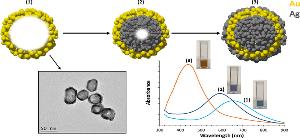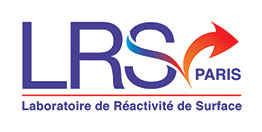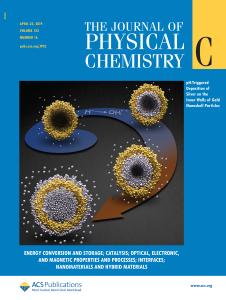Cover for J Phys Chem C

ABSTRACT
Spatially controlled reactions at the nanoscale have attracted increasing interest for fundamental chemistry and for the engineering of novel functional materials. Herein, we demonstrate that pH-triggered reduction of silver ions preferentially occurs at the inner walls of porous and citrate-capped gold nanoshell (AuNS) particles. The reaction initially relies on the presence of sacrificial silver ions inside the AuNS particles as well as in the surrounding preparation solution, and it proceeds upon external addition of silver ions until a solid silver core is formed inside the AuNS particles. Subsequent reduction of silver occurs on the external surface of the solidified AuNS, resulting in a layered and compositionally complex nanoparticle containing both silver and gold. Growth experiments performed in the dark, under white light illumination, as well as near resonance suggest that the reduction reaction is not guided by a plasmonic field enhancement effect. This is in contrast to the recently proposed hot spot mechanism of silver reduction at the rim of nanoholes in a periodic gold array. Our observations point toward a confinement process that proceeds via a continuous supply of silver ions that diffuse from the external solution through the porous shell into the inner volume of the AuNS particles where they become reduced.
Spatially Controlled Reduction and Growth of Silver in Hollow Gold Nanoshell Particles
J. Phys. Chem. C20191231610614-10621
Cover
Also in the section
- Cover in ACS Sensors
- Cover Biosensors
- Article in Nanomaterials
- AuNRs
- Anis arrival
- OrNano-YouTube
- Review in Biosensors & Bioelectronics
- Webinar SCT
- Insplorion - User Meeting
- JSE 2020 - French Electron Spectroscopy Workshop
- Sunny
- Mona arrival
- CNano-SFNano Joint Congress 2019 - Dijon
- Article in ACS Applied Materials & Interfaces
- Mederic Thesis Defense
- Article in Talanta
- Article in Nanoscale Advanced
- Cover for ACS Appl. Nano Mater.
- Nice gathering
- Alexis is leaving !
- Bruno and Raphael defense
- Souhir : Invited Lecture
- Article in biosensors
- Yacine Mazouzi, price
- BioSurf 2019
- Atul Parikh
- Mathieu Nicolas has joined us
- Bruno & Raphael
- Insplorion
- Ceremony for Master diploma
- Lu : PhD defense
- Fadoua's arrival
- Photoniques
- Daoming arrival
- Mathieu's paper in Journal of the Optical Society of America
- Somia Tomane - Thesis Defense
- Walid's arrival
- Valentin's arrival
- David Hu - Thesis defense
- Vincent Pellas - Thesis Defense
- Paper in ACS ANM
- Paper in ACS Sensors
- Yacine Mazouzi Thesis defense
- Issue-cover selected
- Review in Antibiotics
- IEEE Sensors Council France
- IEEE Sensors
- ACS Sensors
- Sara Martinez Concheso
- PhD defense Mathieu Nicolas
- PEP21 school


